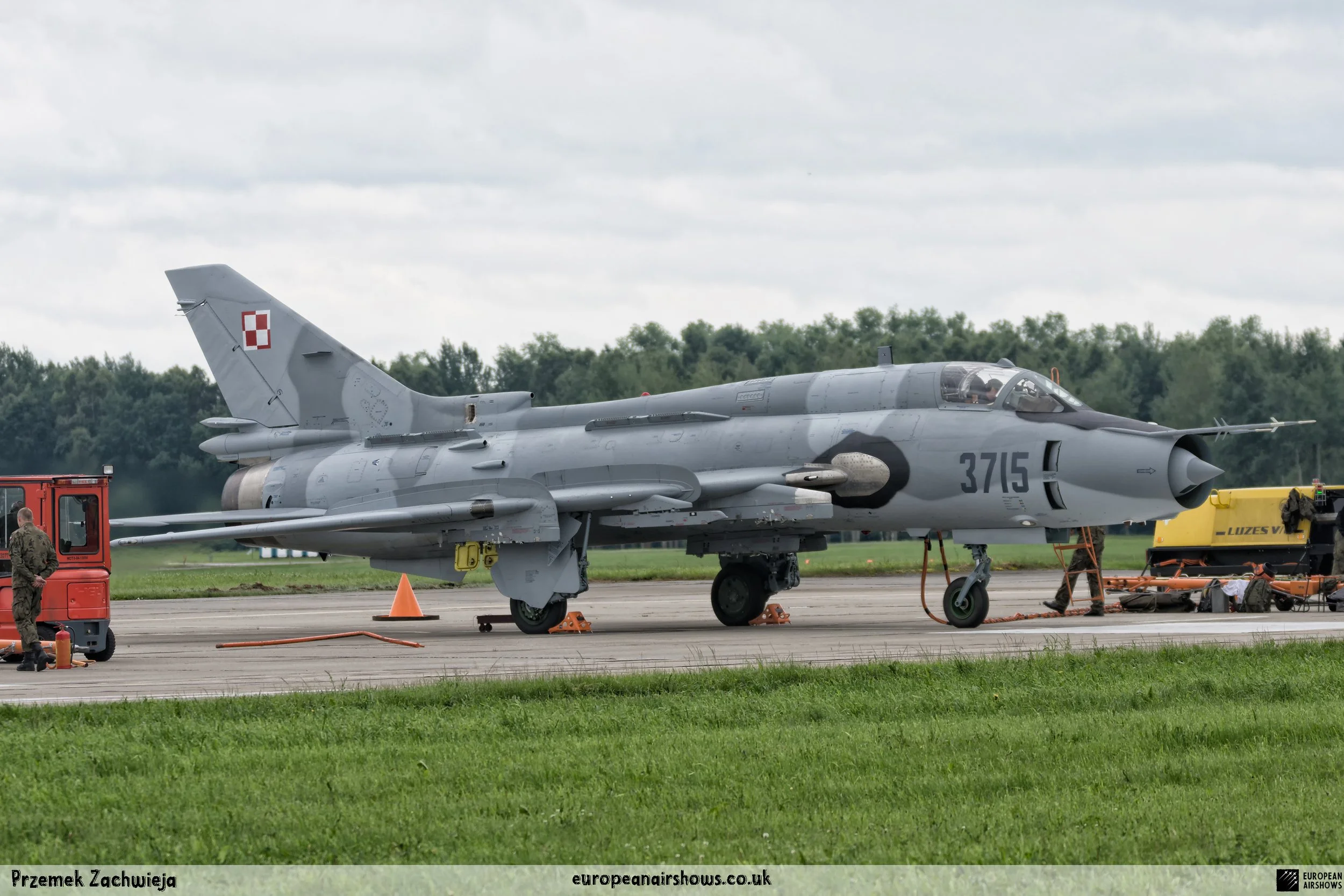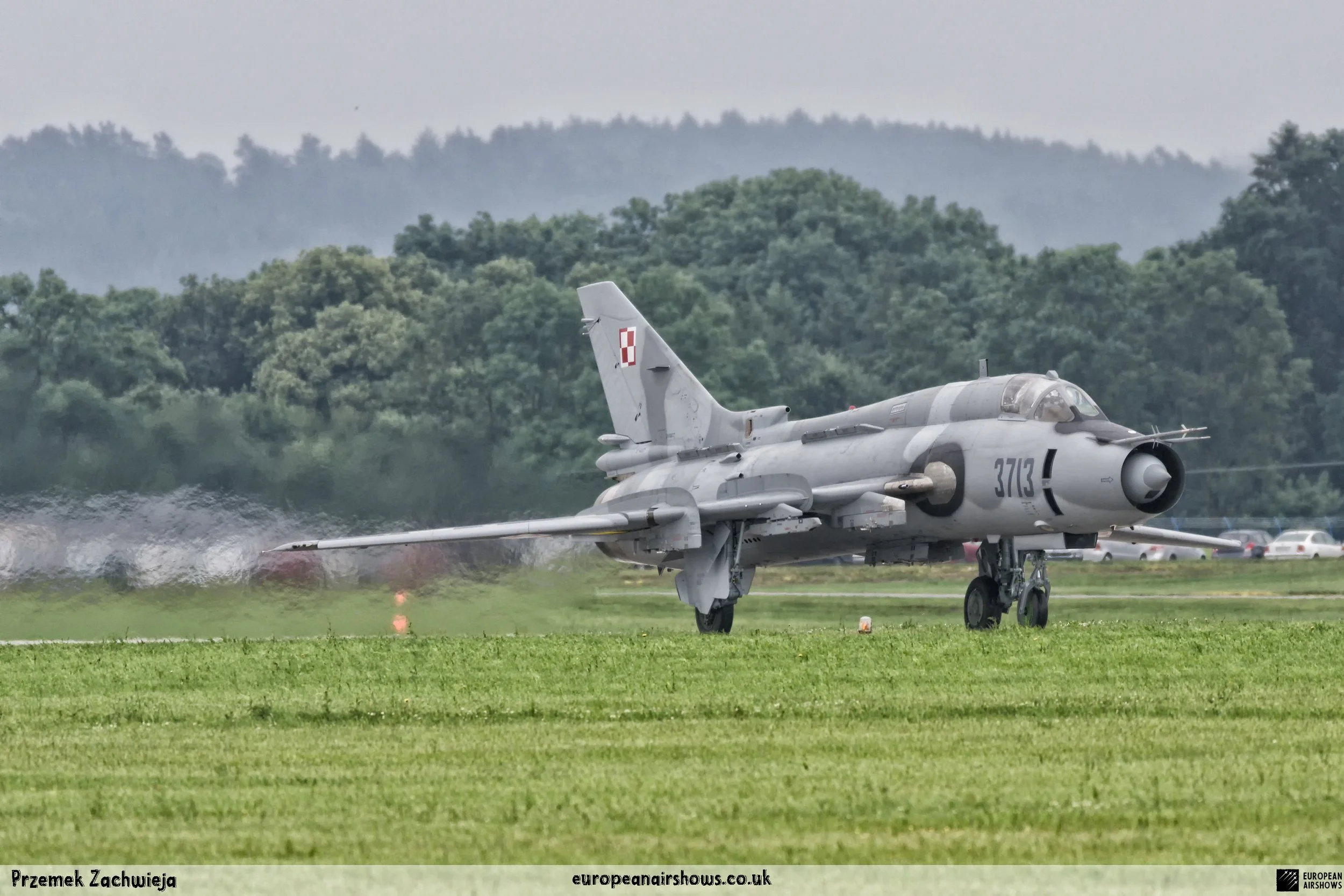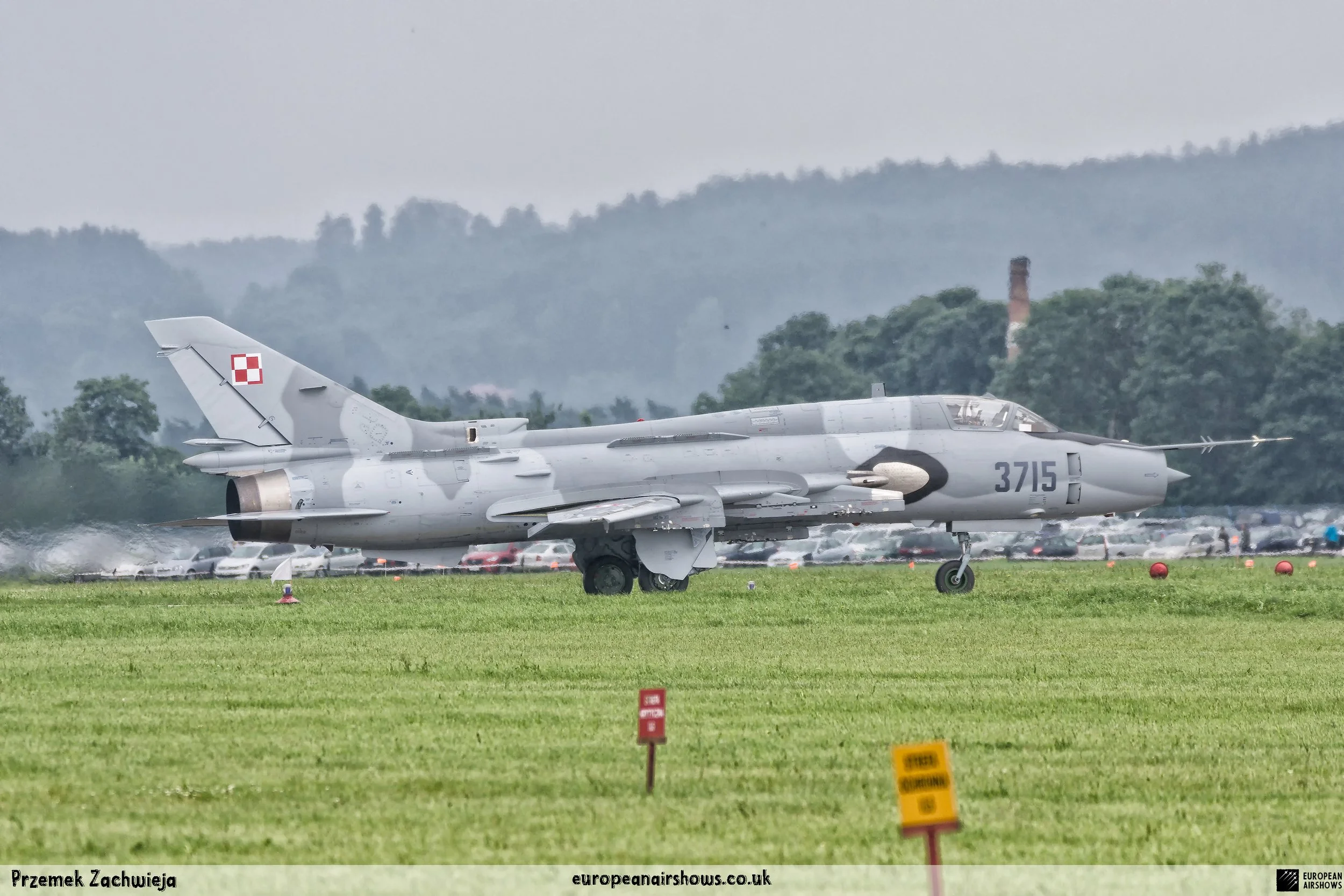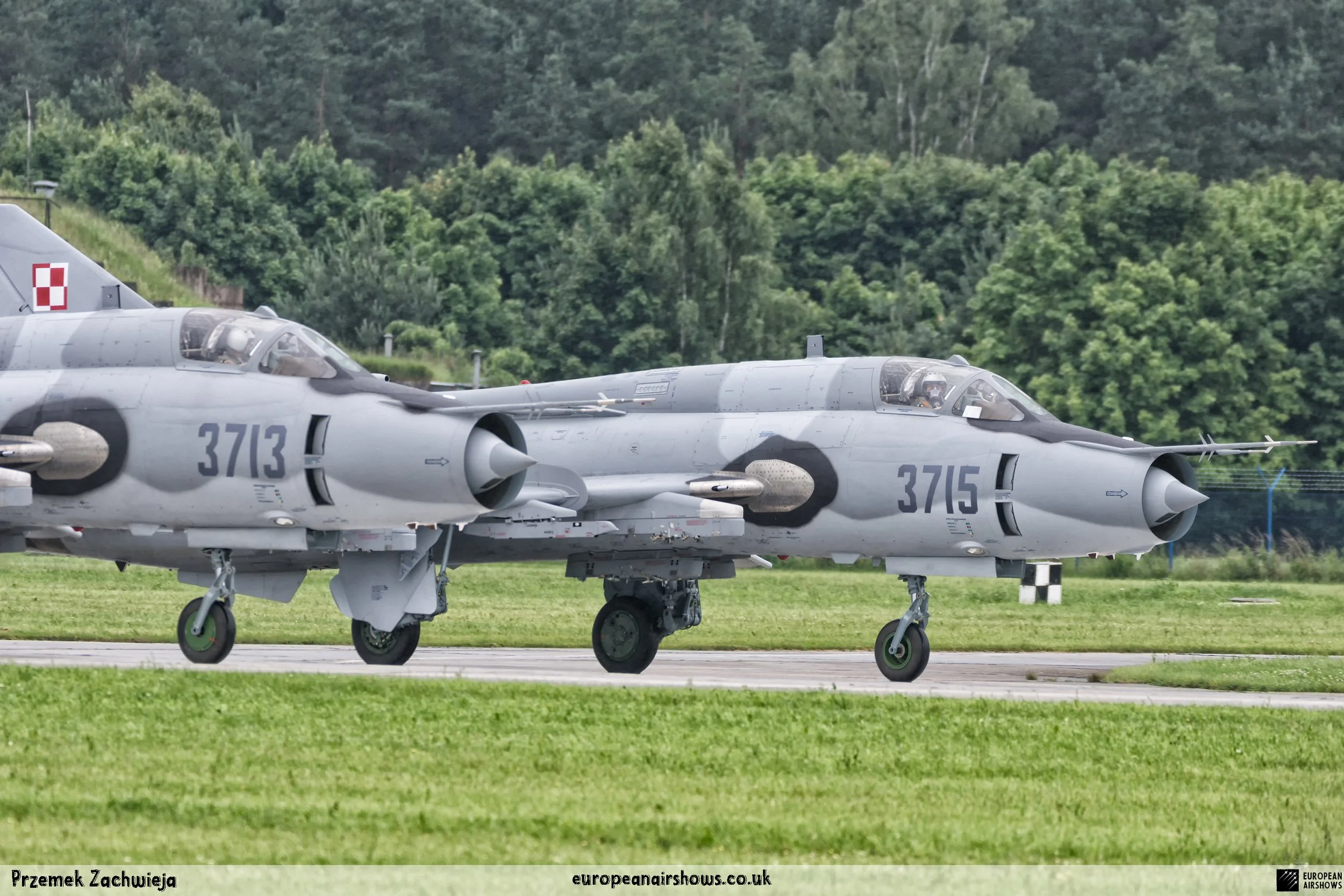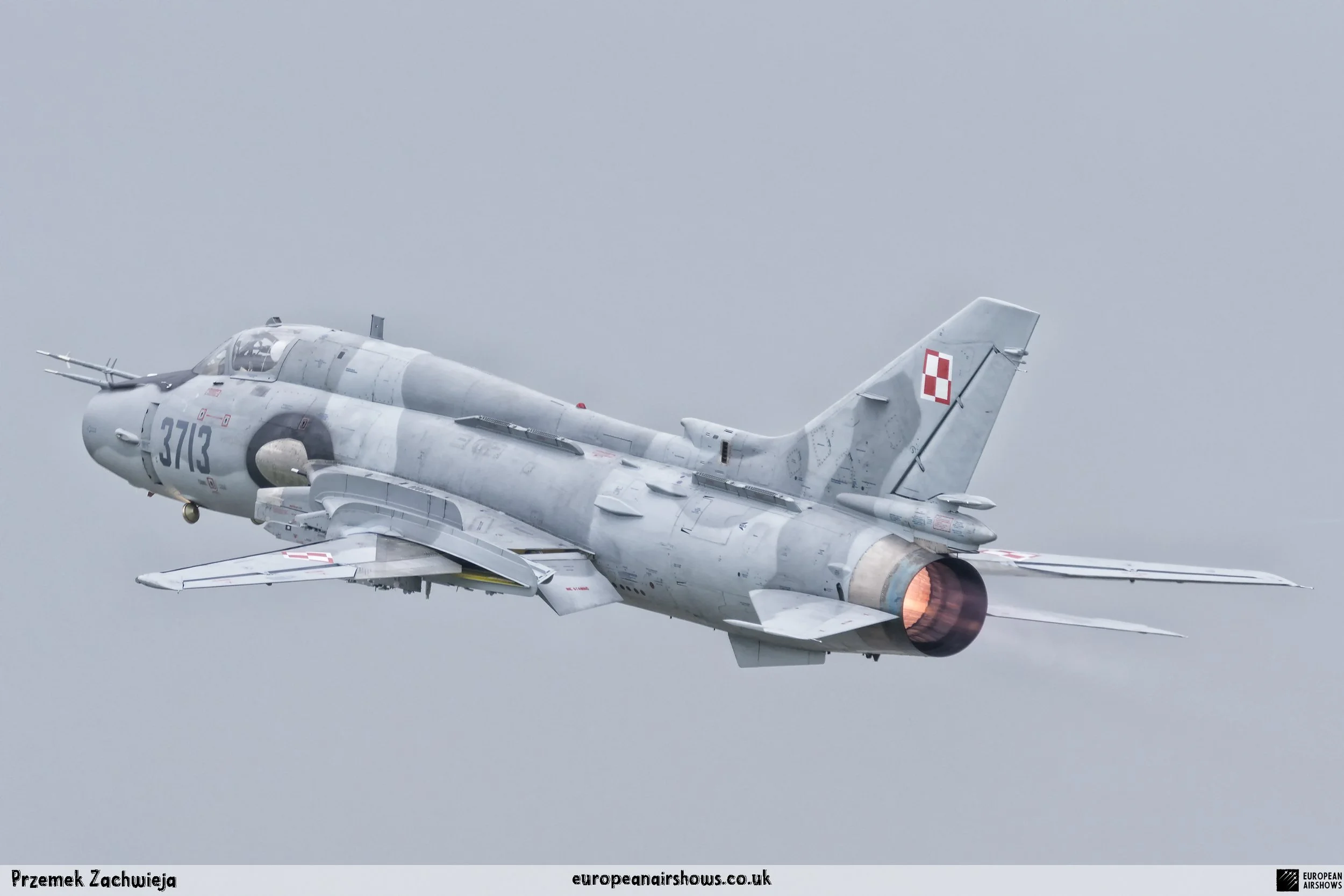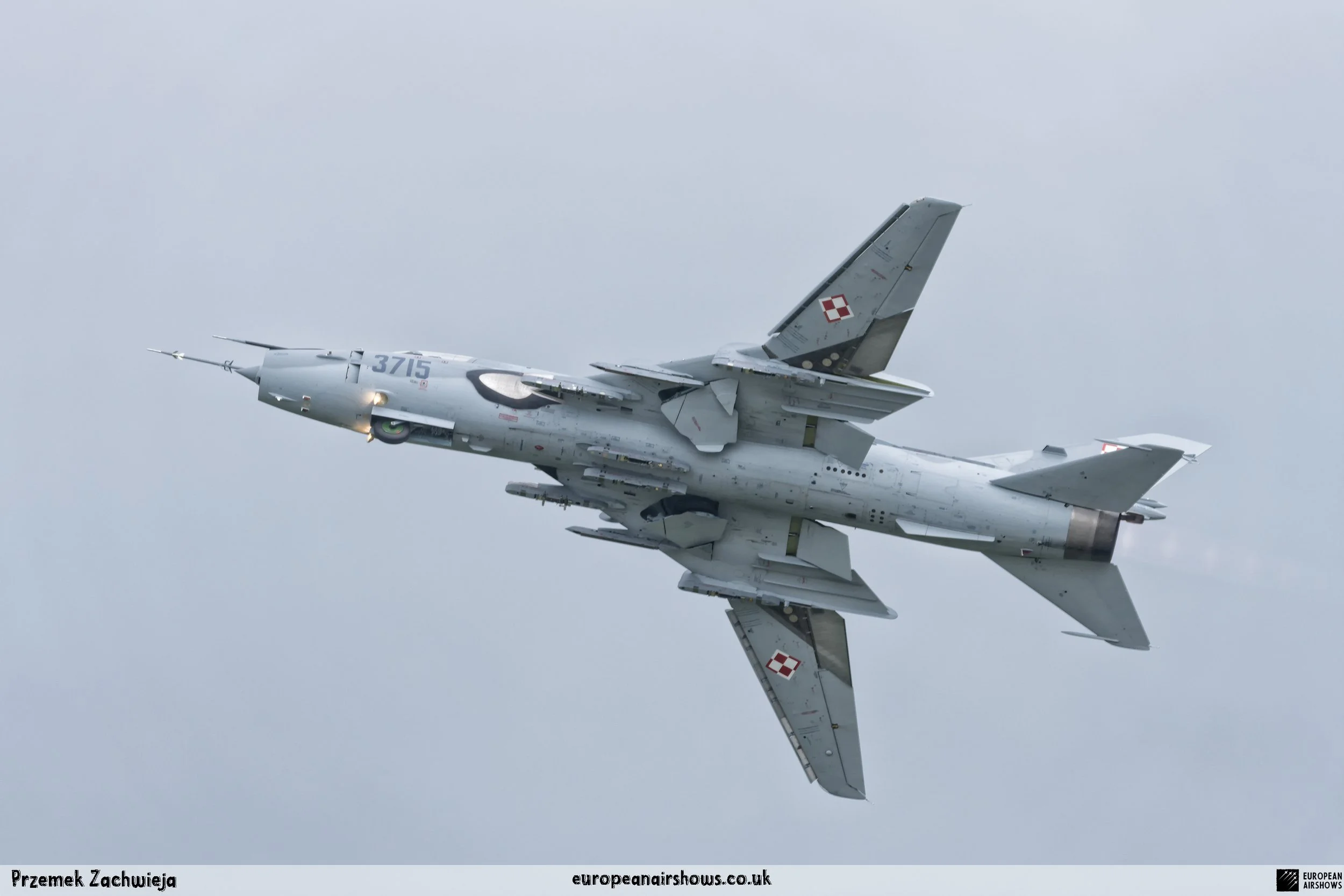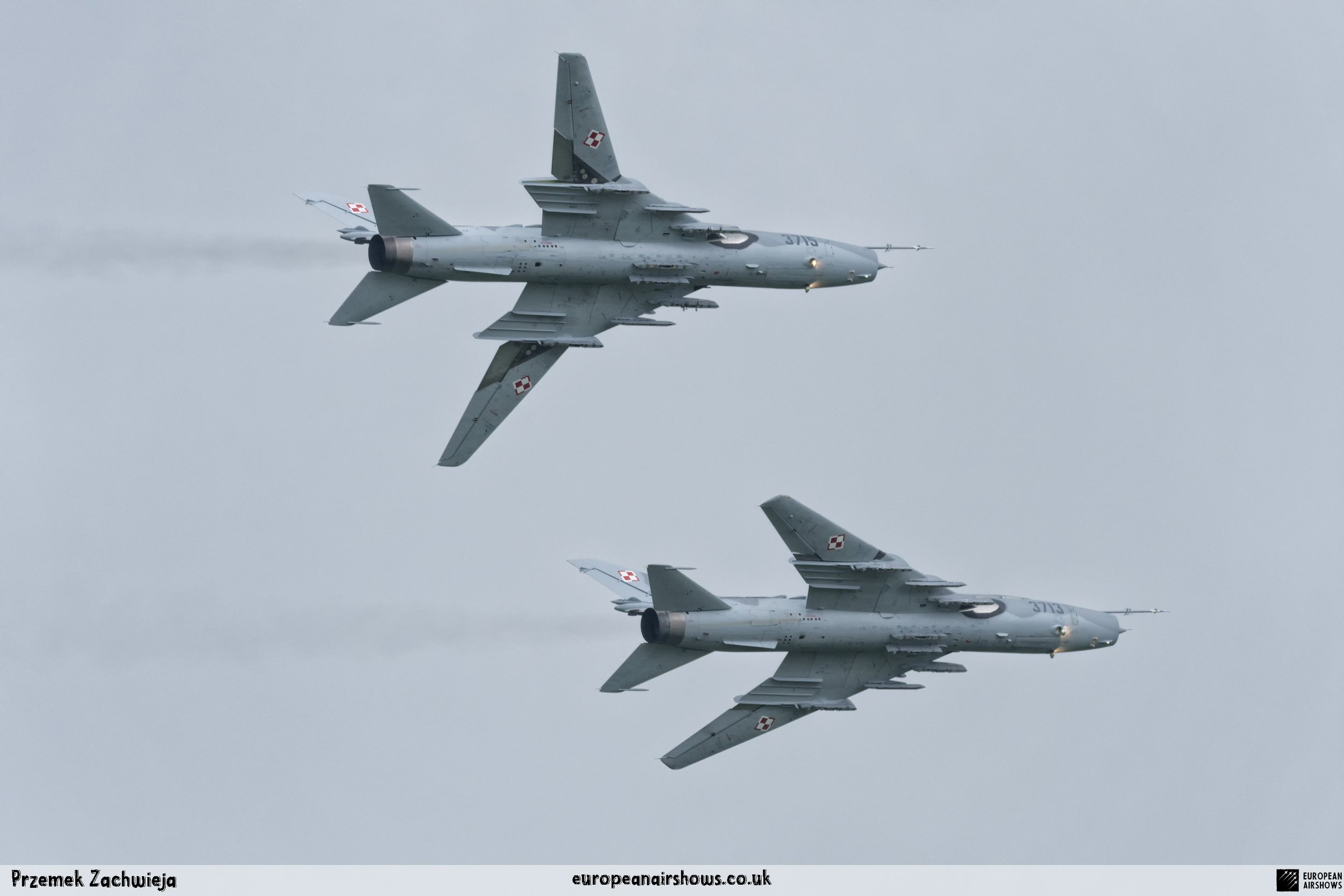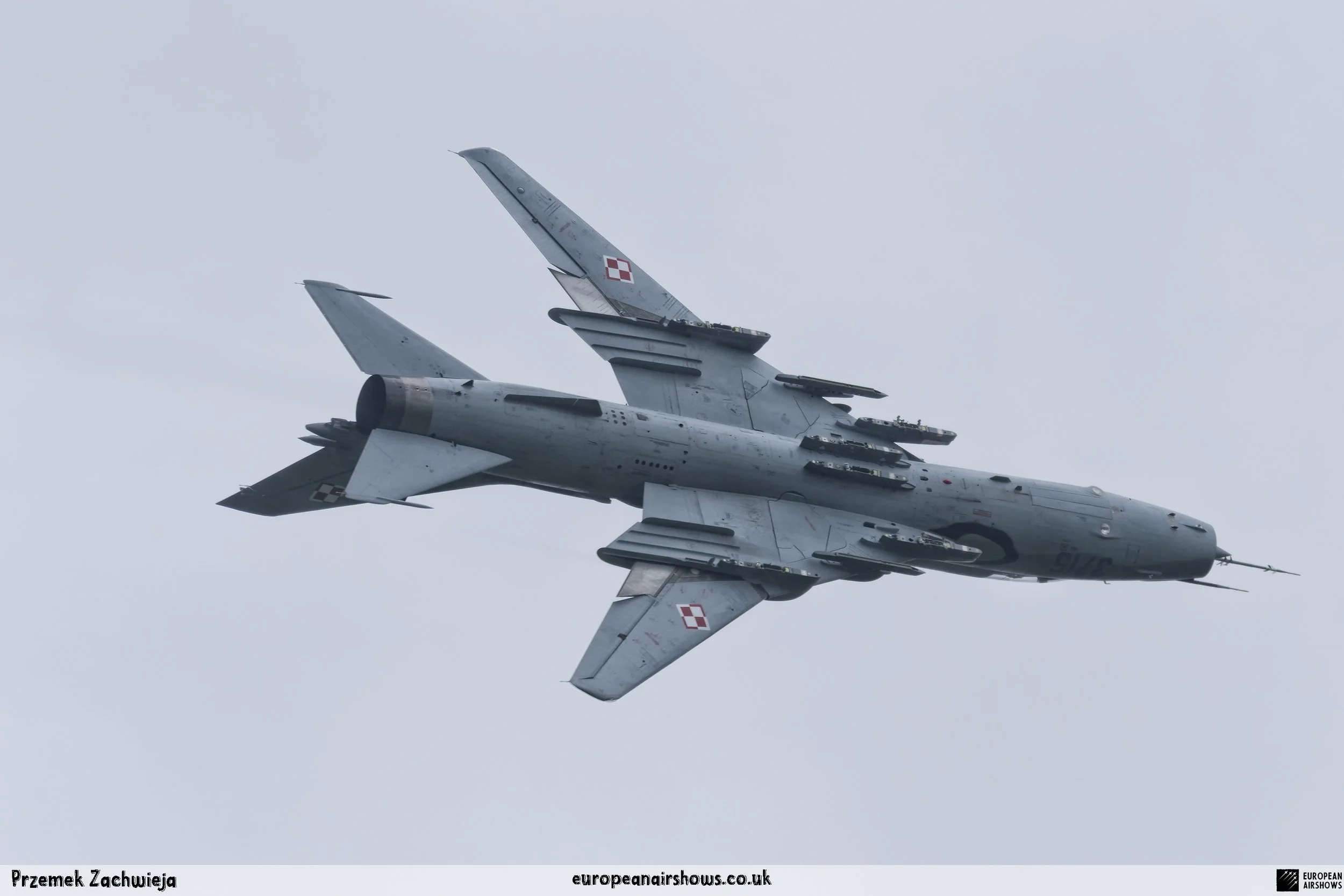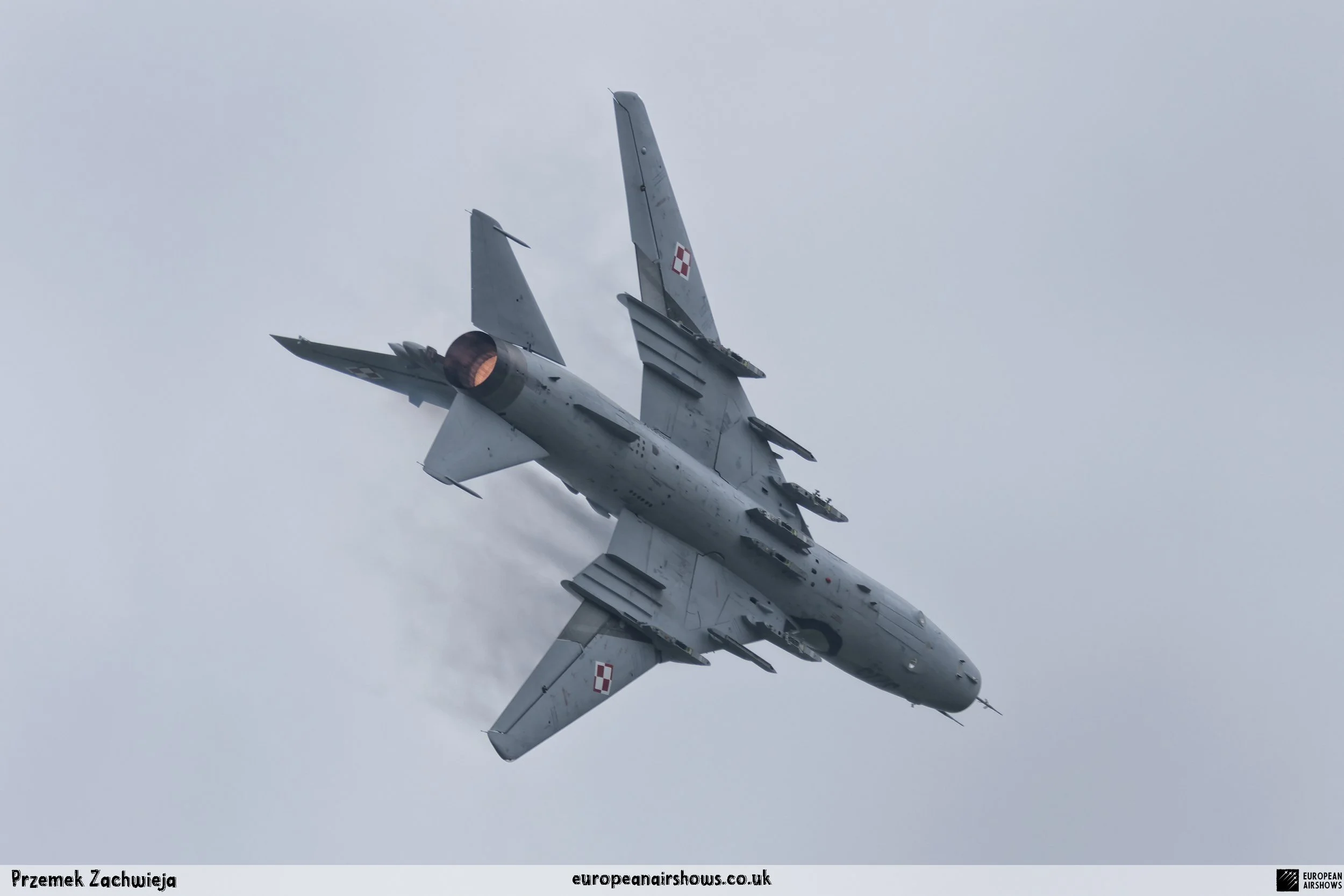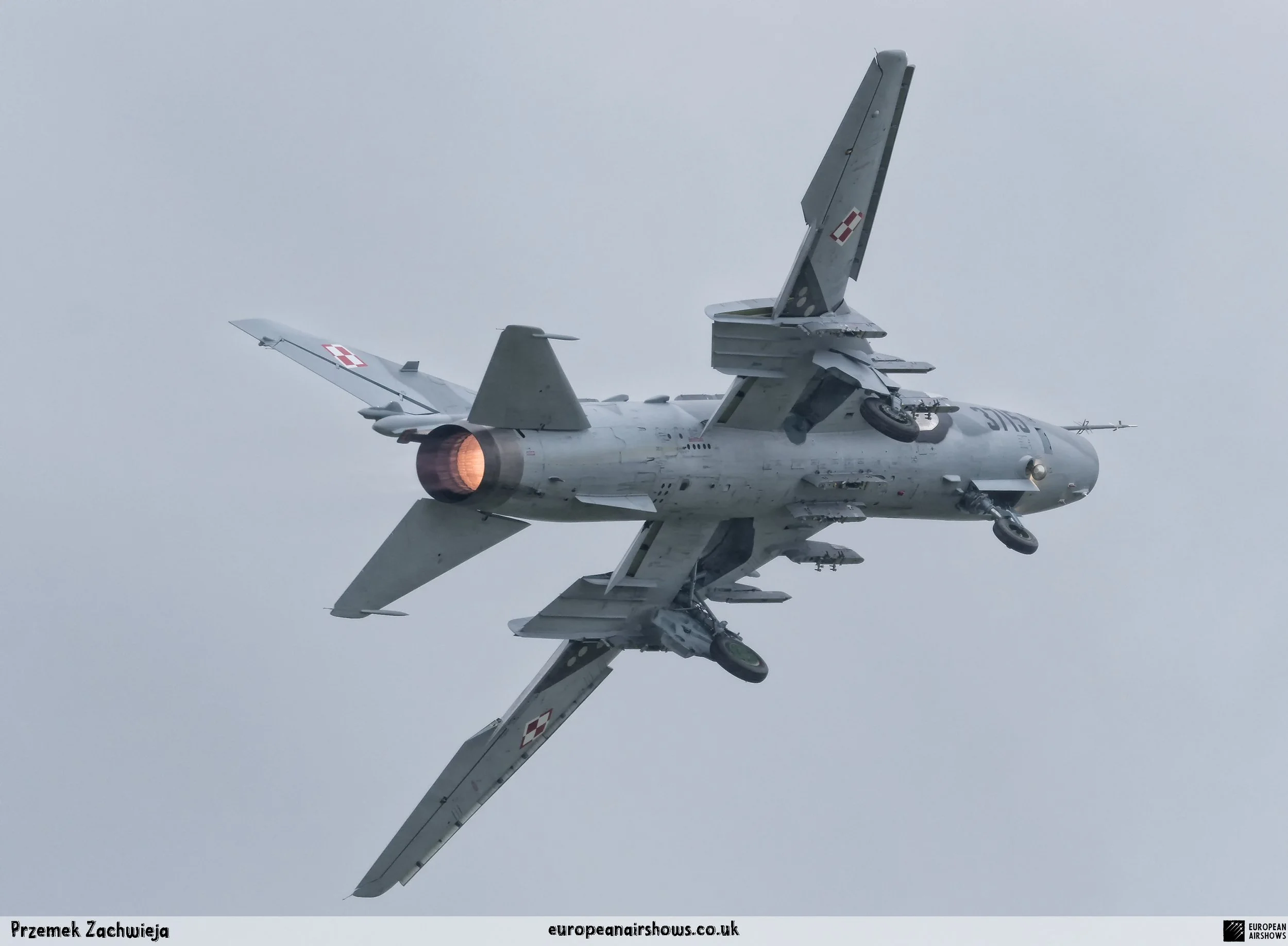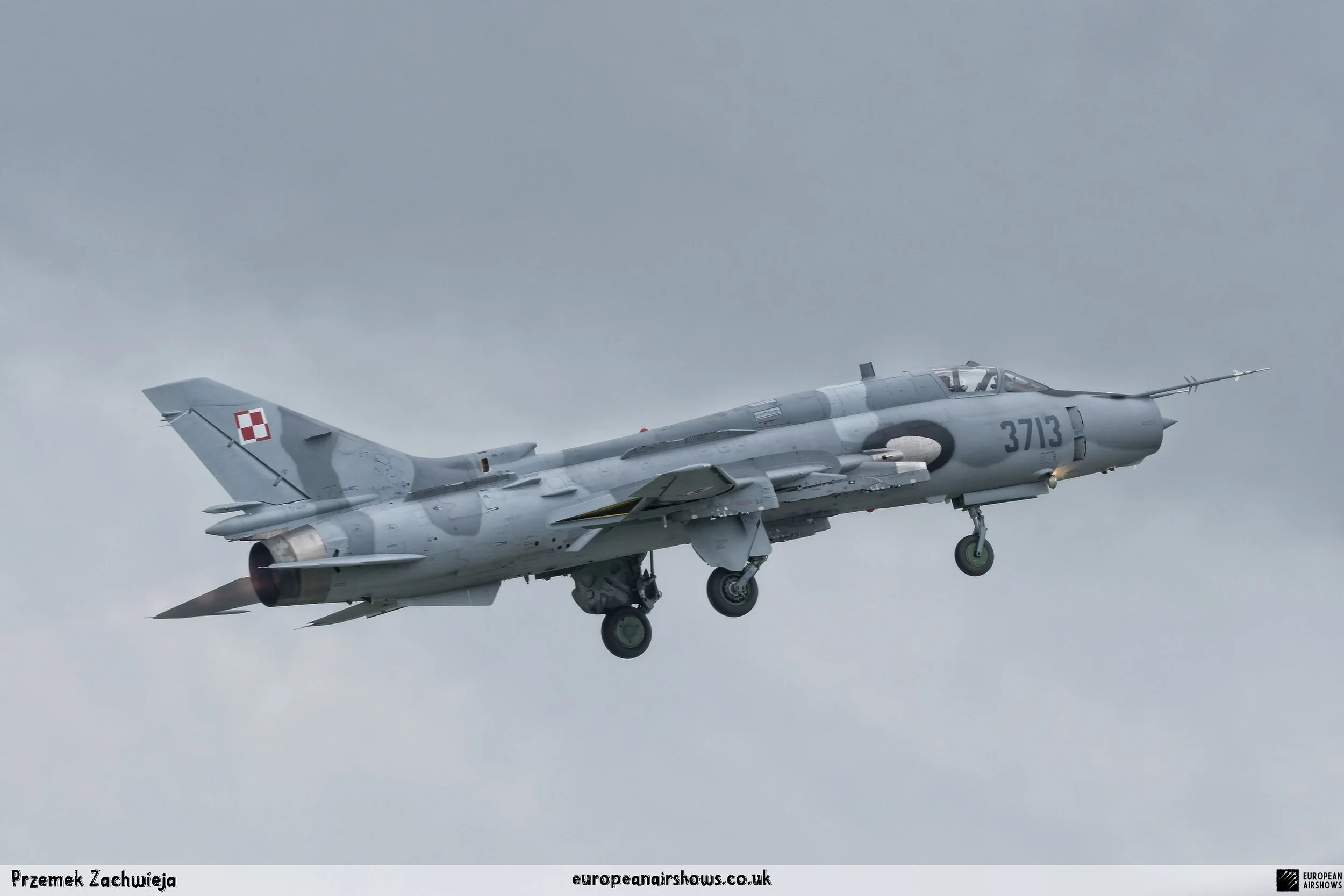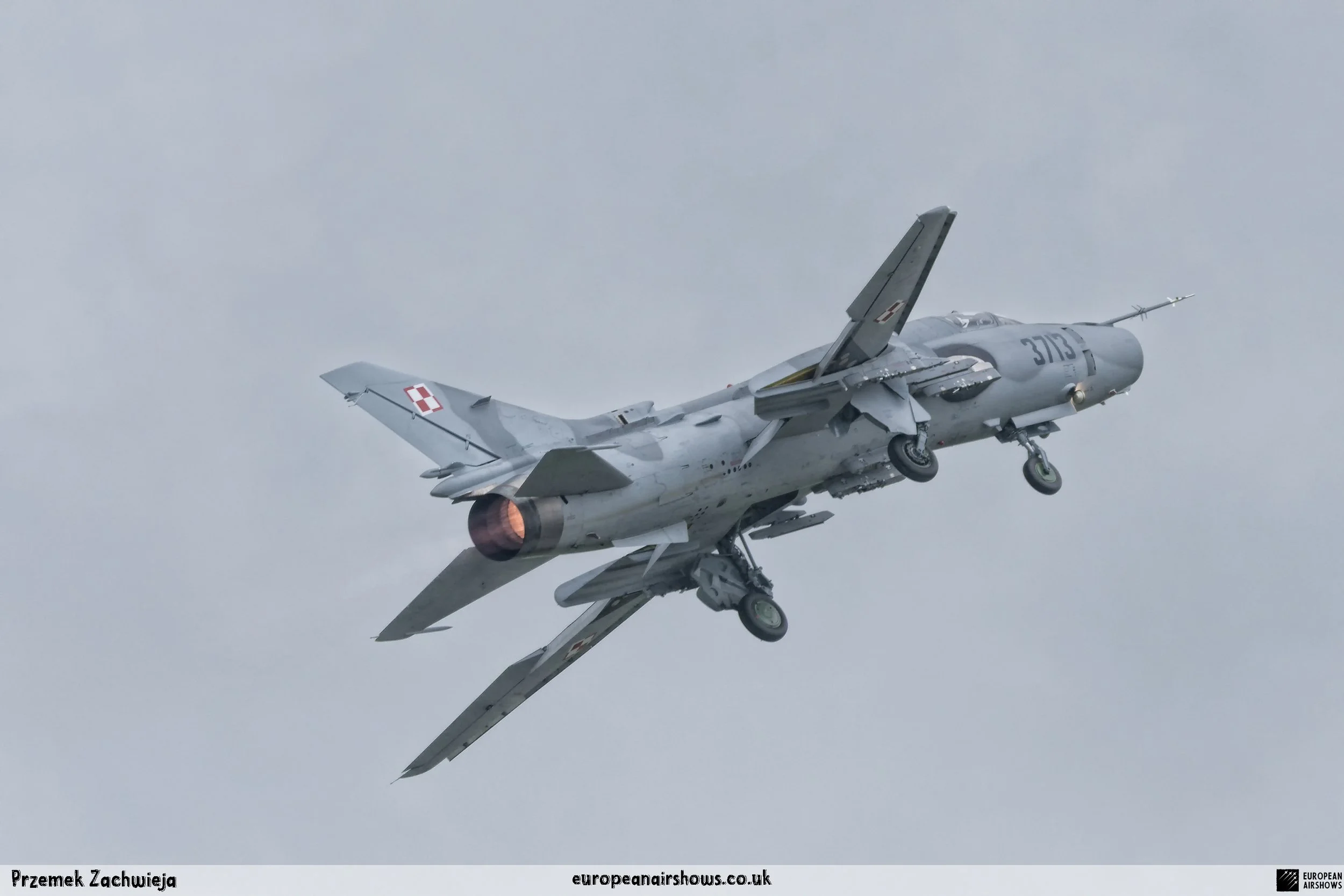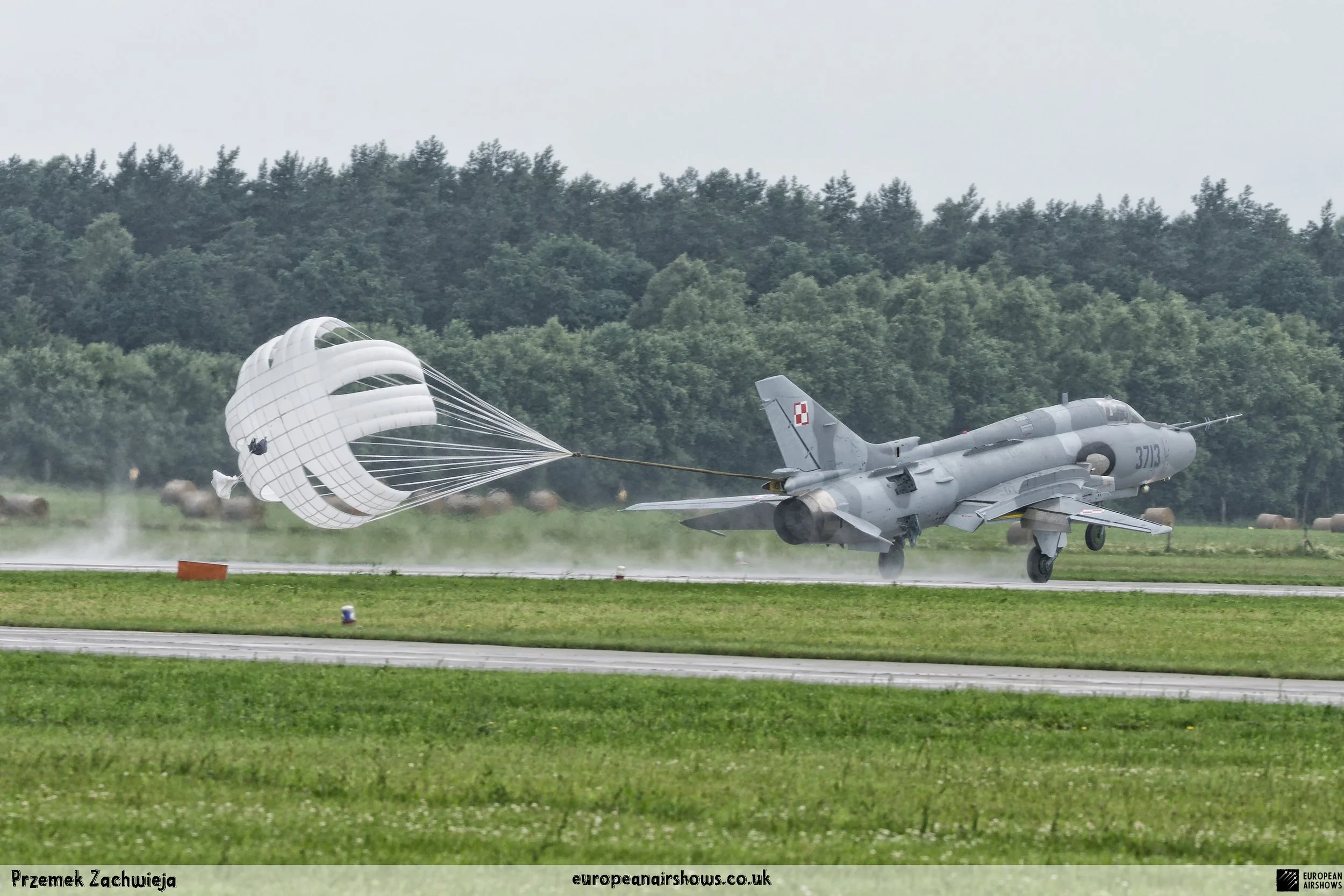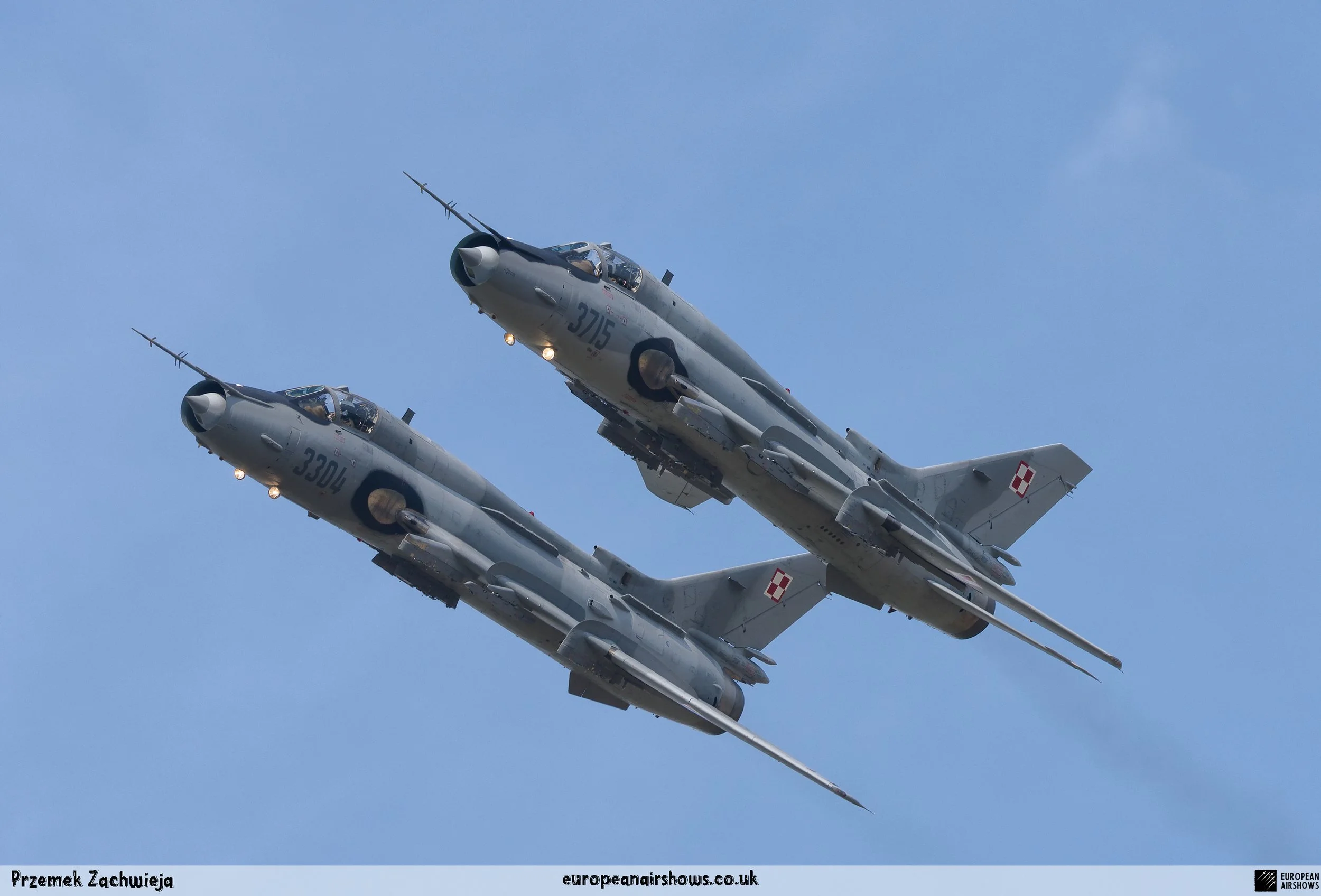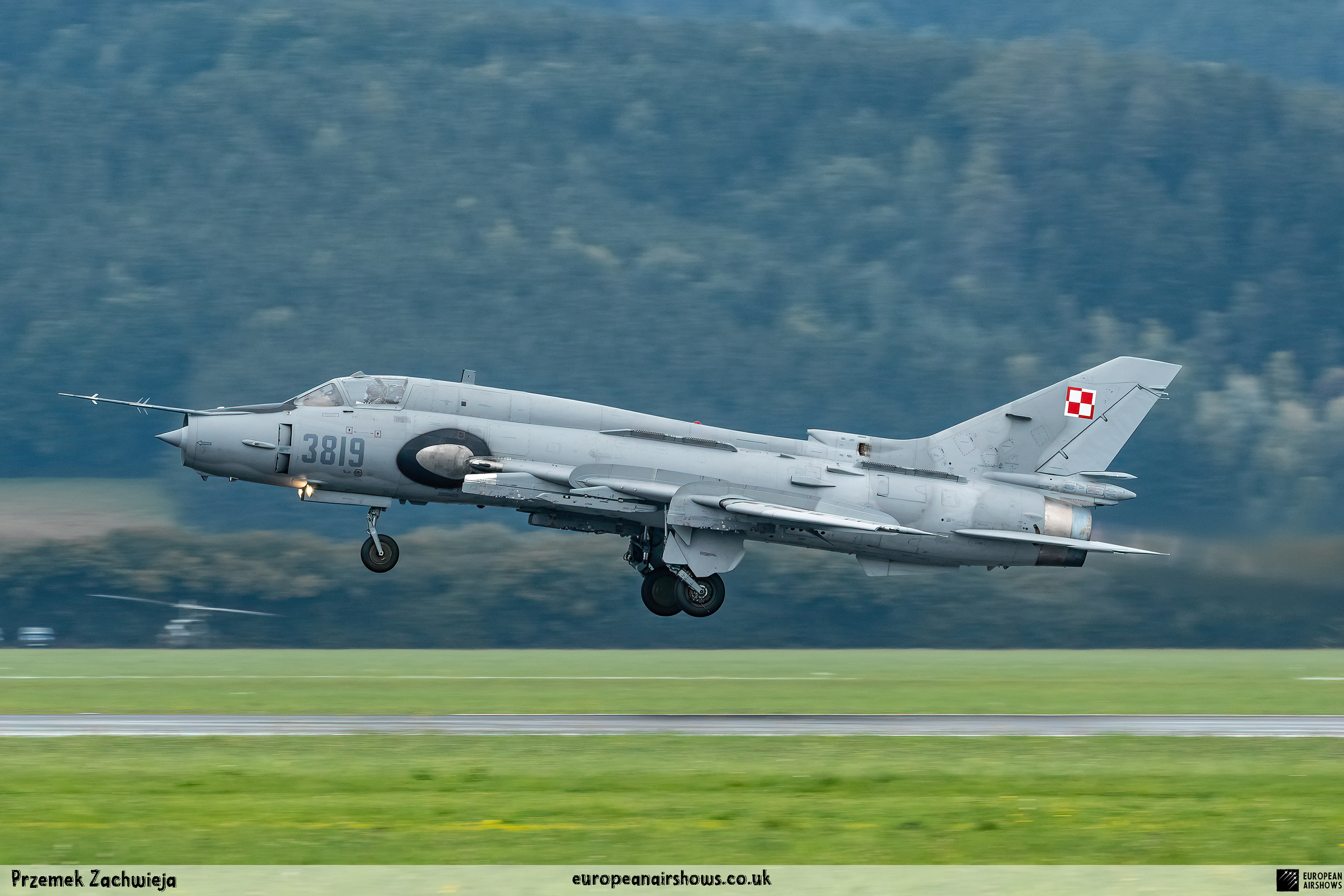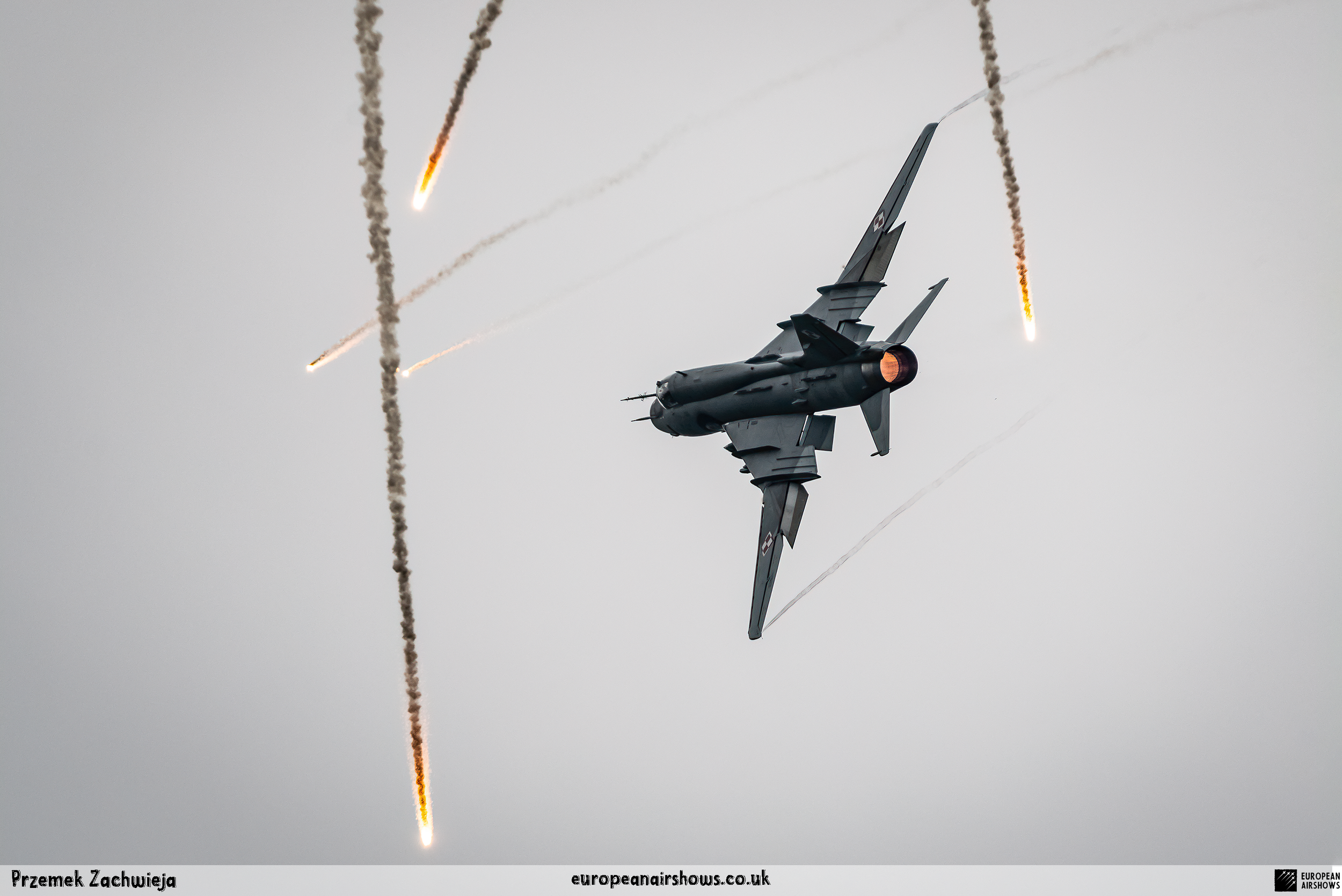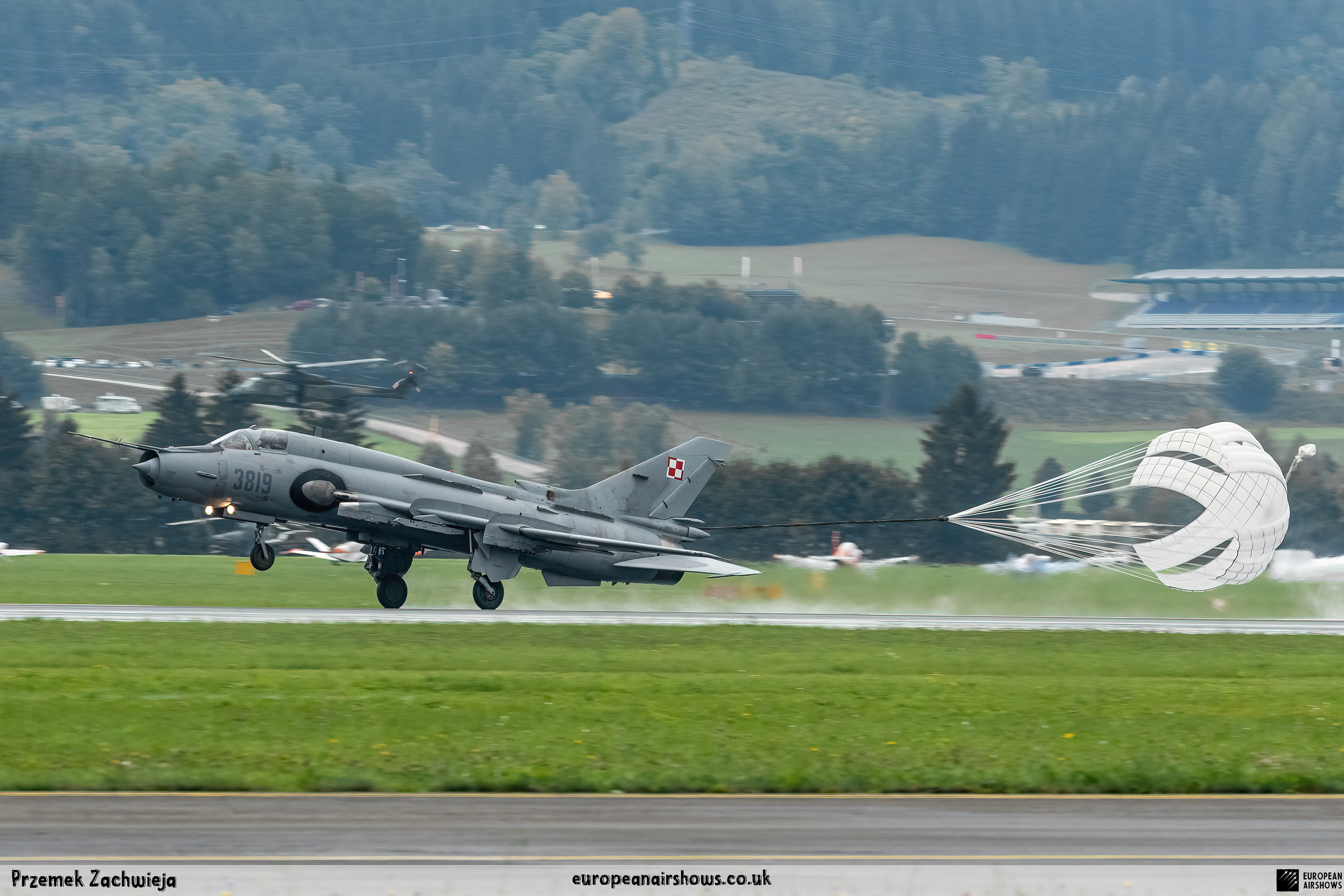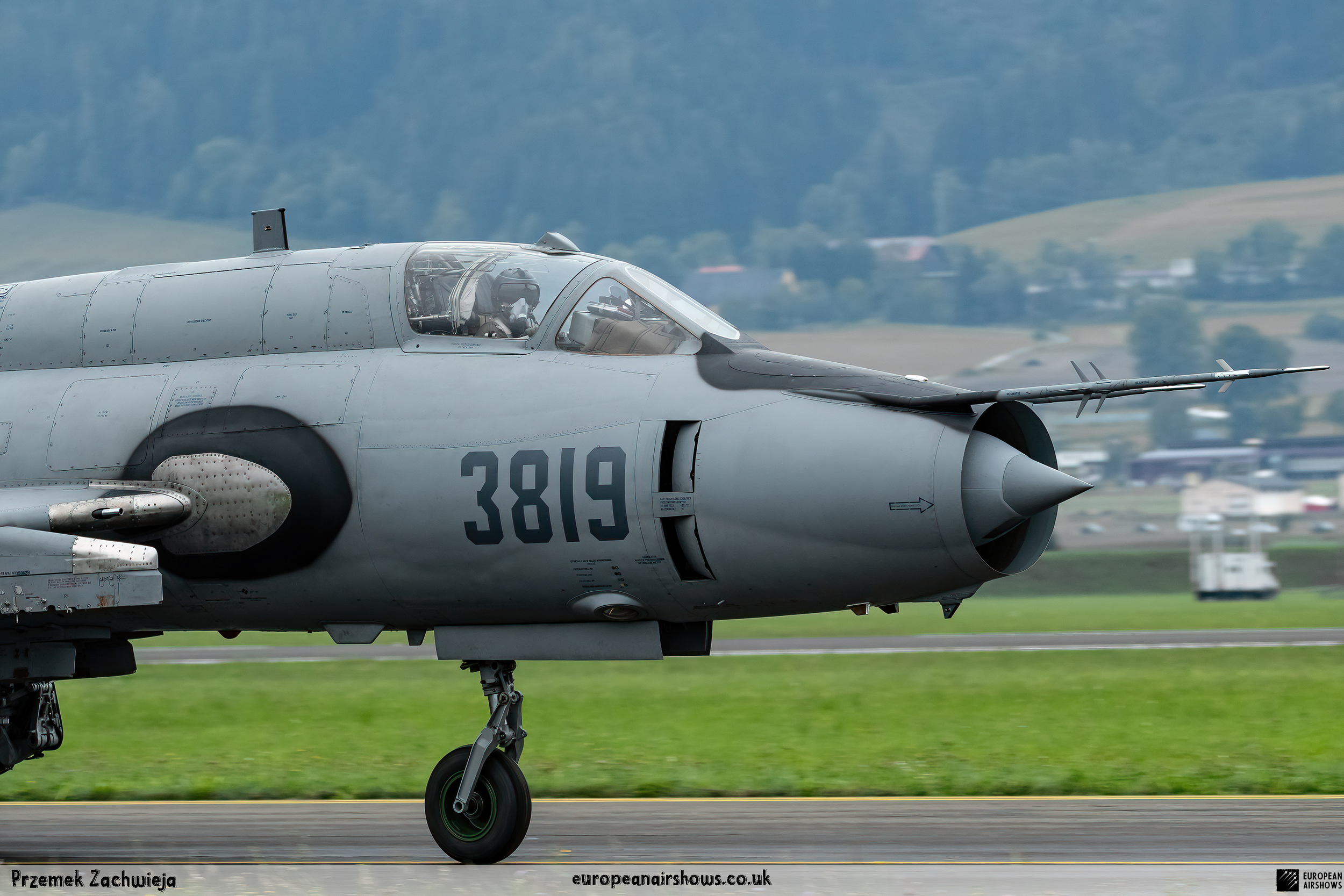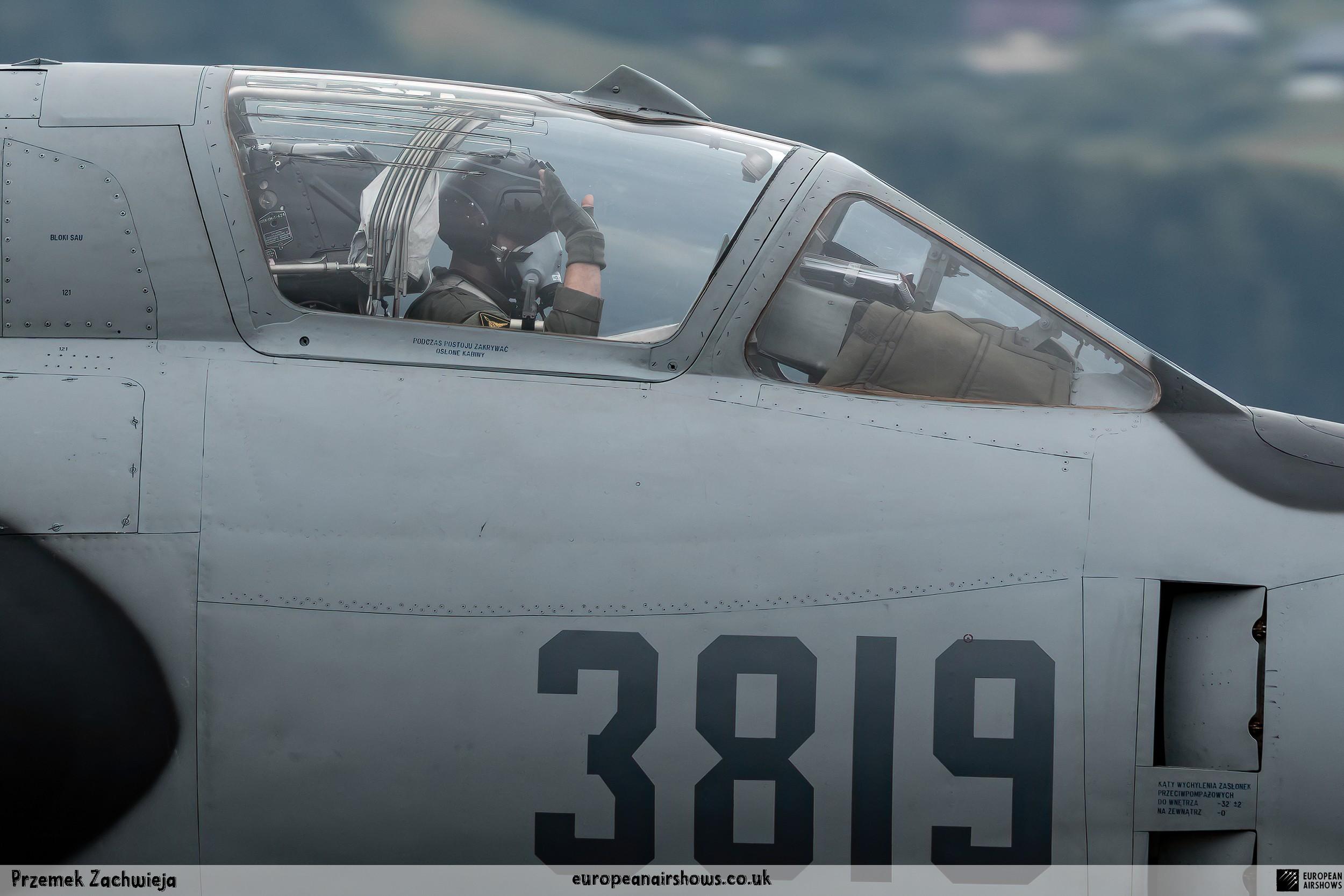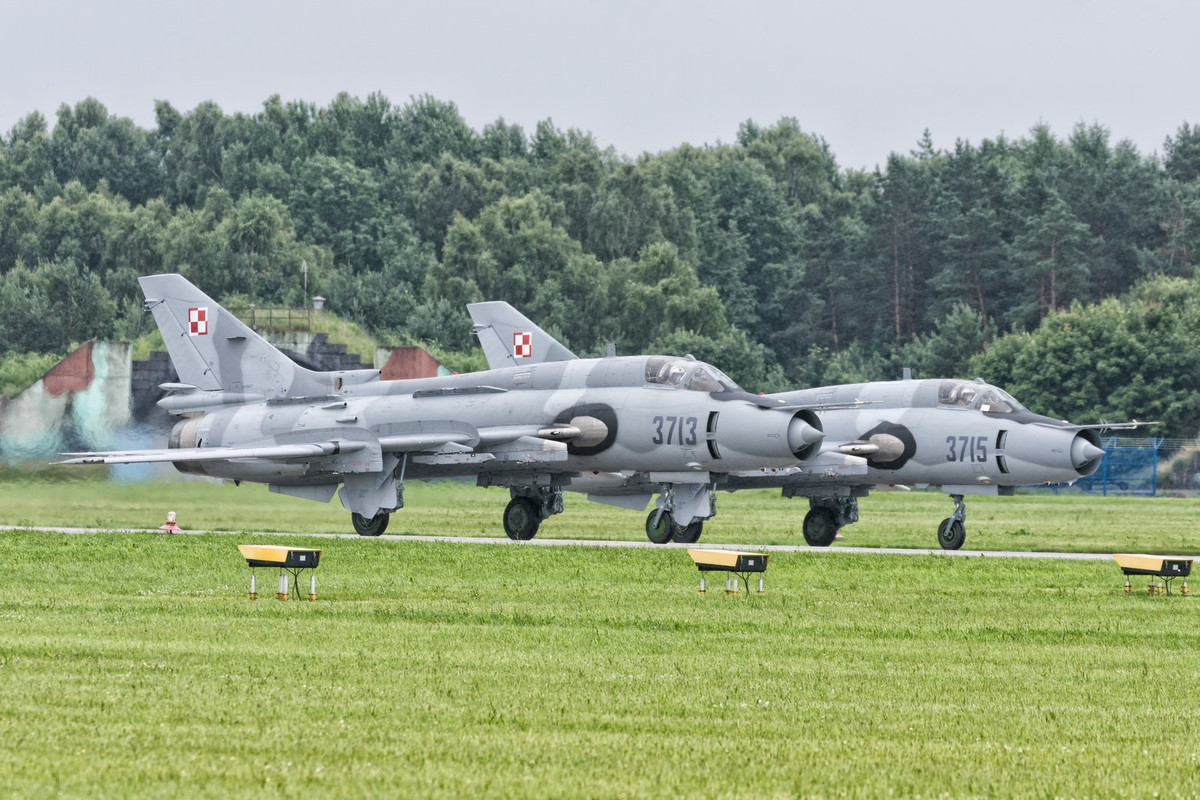
Su-22 Display Team
About the Team
The Su-22 Display Team was a role demonstration team of the Polish Air Force, dedicated to showcasing the capabilities of the Sukhoi Su-22 Fitter aircraft through intricate aerial performances. Based at the 21st Tactical Air Base in Świdwin, the team typically consisted of two highly trained pilots who performed both duo and solo displays.
Their demonstrations highlighted the Su-22’s variable-sweep wing technology, featuring two opening flypasts with distinct wing configurations. Each display lasted approximately ten minutes, during which the pilots executed a series of maneuvers designed to exhibit the aircraft’s tactical versatility and advanced aerodynamics. These maneuvers included high-speed low passes, simulated “bombing runs” where the aircraft would dive towards the ground to mimic a bomb drop, opposition passes, and a variety of missed approaches and go-arounds. Additionally, the team incorporated flares into their performances at select airshows to enhance visual effects and demonstrate the aircraft’s defensive capabilities. The Su-22 Display Team was renowned for their precision, coordination, and the ability to perform complex flight sequences that captivated audiences across Europe.
Team Overview
Number of Aircraft
2
Established
2011
Based
Swidwin Air Base
Aircraft Type
Su-22M4/UM3K
About the aircraft
The Sukhoi Su-22, developed from the Sukhoi Su-17, is a variable-sweep wing fighter-bomber designed for the Soviet military and first introduced in the late 1960s. As the export variant of the Su-17 series, the Su-22 featured enhanced avionics and capabilities tailored for international markets. Produced between 1967 and 1990, the Su-22 became a staple in numerous air forces, including those of the former Soviet Union, Warsaw Pact nations, several Arab states, Angola, and Peru. The aircraft was versatile, performing roles ranging from close-air support to ground attack, and was capable of carrying nuclear ordnance, although it rarely fulfilled this role. Its design emphasized performance and flexibility, incorporating variable-geometry wings that allowed for improved takeoff and landing characteristics, as well as extended range and endurance compared to its predecessors.
In the Polish Air Force, the Su-22M4 variant represented a significant modernization effort aimed at extending the operational life of the existing fleet. Introduced in the early 1980s, the Su-22M4 featured upgraded avionics, including advanced navigation systems and radar warning receivers, which enhanced its combat effectiveness and survivability in modern warfare environments. Economically, Poland opted to retain the Su-22M4s to support its domestic aerospace industry, specifically the WZL nr 2 repair facility in Bydgoszcz, ensuring that maintenance and repairs were conducted locally. The Su-22M4s were also favored for their relative ease of maintenance compared to contemporary aircraft like the MiG-29 and F-16, boasting a high operational reliability with a non-error index of 70–75%. Additionally, the Su-22M4 was uniquely equipped for electronic intelligence and warfare, making it invaluable for supporting ground operations and maintaining a strategic advantage.
Complementing the Su-22M4, the Polish Air Force also operated the Su-22UM3K variant, a two-seat trainer and combat version designed to facilitate the training of new pilots and maintain the proficiency of existing crews. Manufactured between 1978 and 1982, the Su-22UM3K retained the robust avionics suite of the Su-17M3 while incorporating structural modifications to accommodate tandem cockpits for student and instructor. This variant ensured that Poland could sustain a well-trained cadre of pilots capable of effectively utilizing the Su-22’s advanced systems. The Su-22UM3K also supported the deployment of a wide array of air-to-ground weapons, maintaining a substantial arsenal that further underscored the aircraft’s strategic value. As Poland prepares to transition to newer aircraft like the KAI FA-50, the Su-22M4 and Su-22UM3K continue to serve in active duty, with plans for their retirement anticipated by the end of 2025.
Team History
Founded in 2011, the Su-22 Display Team quickly established itself as a prominent aerial demonstration unit within the Polish Air Force. From its inception, the team embarked on numerous sorties across Europe, participating in a variety of international airshows and military exhibitions. Their skillful performances and professional demeanor earned them several accolades, most notably the ‘As The Crow Flies’ Trophy for Best Overall Flying Demonstration at the Royal International Air Tattoo in 2014, one of the world’s largest and most prestigious airshows. Throughout its active years, the Su-22 Display Team consistently delivered high-quality demonstrations, contributing to Poland’s reputation in the field of aerial displays.
In 2019, the team underwent significant changes, performing only a limited number of paired displays within Poland. These pair displays were notably shorter than their traditional duo demonstrations. Additionally, the team shifted focus to predominantly solo performances for most events. The most memorable solo display occurred at their final international appearance during AirPower Zeltweg 2019. At the conclusion of the 2019 display season, both original display pilots retired from their roles, leaving the team temporarily without pilots.
The Su-22 Display Team made a brief return in 2021 with new pilots, resuming activities shortly after the COVID-19 pandemic. However, these performances were markedly more subdued, featuring shorter durations and reduced use of afterburners, deviating from the dynamic displays previously characteristic of the team. Following 2021, the Su-22 Display Team was officially disbanded. Nevertheless, the Sukhoi Su-22 aircraft continued to participate in flypasts at various events around Poland and featured in static displays. The legacy of the team persisted with notable appearances, including a static display at the Royal International Air Tattoo in 2023, marking the enduring presence of the Su-22 within the realm of aerial exhibitions.
Did You Know?
- The Su-22 Display Team of the Polish Air Force was established in 2011 and won the ‘As The Crow Flies’ Trophy for Best Overall Flying Demonstration at the Royal International Air Tattoo in 2014.
- The Su-22 Fitter was the first variable-sweep wing aircraft to enter Soviet service, showcasing advanced design features that improved takeoff and landing characteristics.
- The Su-22 Display Team performed both duo and solo displays, with a typical demonstration lasting about 10 minutes, showcasing the aircraft’s tactical capabilities and variable-sweep wing features.
- The Su-17/20/22 series has been operated by numerous air forces worldwide, including those in the Arab world, former Soviet republics, and even in countries like Angola and Peru.
- The Su-22 was capable of carrying free-fall nuclear bombs, and it had a special code device in the cockpit to prevent unauthorized use of such weapons.
Test Your Knowledge
Inactive Status
The team was disbanded at the end of 2021


